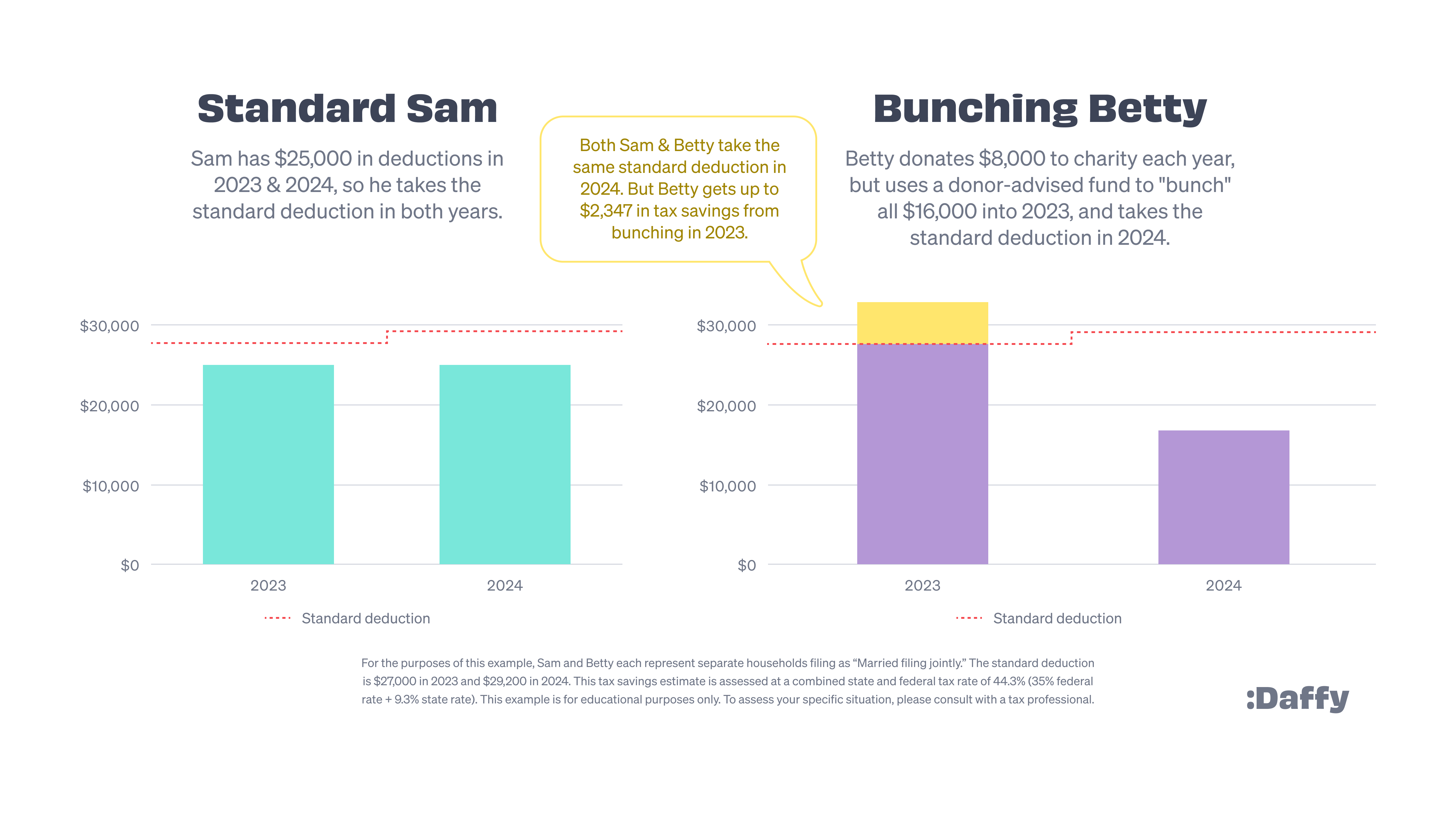
Are you one of the 60 million generous households in America that give to charity each year? If so, you might be missing out on one of the best tax deductions in the tax code. Fortunately, there is a simple strategy that can help save you thousands of dollars when you file your taxes for 2023 — it’s called bunching.
In 2017, the Tax Cuts and Jobs Act roughly doubled the standard deduction through 2025. But while this large deduction helped lower taxes for millions of households, it also made it more difficult to qualify for a lot of common individual tax deductions, including one that is near and dear to the hearts of many — the tax deduction for charitable giving.
However, there is good news. A simple tax strategy called “bunching,” or “bundling,” can let taxpayers who don’t normally qualify for itemized deductions get access to the charitable deduction. All it requires is a little planning and access to an account called a donor-advised fund (DAF).
From just $107.88 $24.99 for Kiplinger Personal Finance
Become a smarter, better informed investor. Subscribe from just $107.88 $24.99, plus get up to 4 Special Issues

Sign up for Kiplinger’s Free Newsletters
Profit and prosper with the best of expert advice on investing, taxes, retirement, personal finance and more - straight to your e-mail.
Profit and prosper with the best of expert advice - straight to your e-mail.
Bunching: A tax strategy you should know
The concept behind bunching is simple. Instead of taking the standard deduction every year, by grouping your charitable contributions for multiple years together into a single tax year, you can exceed the standard deduction and take advantage of valuable itemized deductions like charitable donations.
The 2023 standard deduction for married couples filing jointly is $27,700, and in 2024, it will rise an additional $1,500 to $29,200. For single individuals and married couples filing separately, the standard deduction is $13,850, rising to $14,600 in 2024. For most households, that level is difficult to clear, and in 2024, it will get even more challenging. As a result, 2023 is an excellent year to take advantage of this strategy.
Examples: Standard Sam and Bunching Betty
Let’s look at a simple example of how this strategy can work and potentially save you thousands of dollars in taxes. Meet Standard Sam and Bunching Betty.
Now, while Sam and Betty don’t know each other, it turns out they have a lot in common. Both Sam and Betty give generously to charity every year, making $8,000 in annual donations to their church, their children’s schools and other charities. In 2023, they both also have $17,000 in other deductible expenses, like mortgage interest and property taxes. As a result, each of their households ends up every year with about $25,000 in tax deductions — not enough to clear the hurdle to itemize.
Standard Sam decides to take the standard deduction of $27,700 in 2023. This makes sense to him, of course, since his itemized deductions of $25,000 would be lower. In fact, Standard Sam ends up taking the standard deduction in both 2023 and 2024.
Bunching Betty knows better. Looking ahead to 2024, she knows that her household will make about $8,000 in charitable donations again. Instead of taking the standard deduction two years in a row, she puts the $8,000 she intends to give out in 2024 into a DAF, a tax-advantaged account for charity, before Dec. 31, 2023. Since this is considered a charitable contribution, this allows her to claim the tax deduction for this contribution in 2023. Her deductions for 2023 now come to $33,000, well over the standard deduction.
As a result, Bunching Betty gets an additional deduction of $5,300 in 2023, while still qualifying for the standard deduction in 2024. At a combined state and federal tax rate of 44.3% (35% federal plus 9.3% state), that could mean tax savings of as much as $2,347!

Of course, the best part of this strategy is that it helps ensure that the money that Betty will need to support her charities is safely put aside for 2024, invested tax-free in the DAF. And who knows, perhaps gains on those investments will provide for even more charitable donations in 2025!
It’s not too late to open a DAF and bunch your donations
DAFs have been around for decades, and they are rapidly growing in popularity due to the convenience and flexibility they offer. There are more than 1.9 million DAF accounts in the U.S. now, according to the National Philanthropic Trust, and they have grown by an average of 22.6% per year since 2018.
Once you learn about tax strategies like bunching, it’s easy to understand why. DAFs allow you to contribute money at any time, immediately qualify for the charitable deduction in the current tax year, invest the money tax-free and then make donations to charities at your discretion.
Bunching charitable contributions isn’t right for everyone, but if your household donates to charity regularly, it would be foolish not to consider it. This strategy can be done in any year but could be even more valuable in years where you have extra income and might even be in a more expensive tax bracket.
There are three steps to leveraging this strategy:
- Estimate your deductions for this year. Did you take the standard deduction last year? The year before? Many people don’t know this offhand, but finding out can be as simple as just referring to your taxes from last year or asking your accountant. Look for significant changes in your deductions: mortgage interest, state and local taxes, etc.
- Look at your charitable giving annually. Most people who give to charity tend to support the same organizations every year combined with a few donations that were made based on current events or a specific request. How much did you give to charity this year? How much will you likely give to charity next year?
- Set up a DAF. Charitable bunching doesn’t mean you have to rush to decide on how to distribute your funds. Most major brokerages offer some form of DAF account, although many of them have high minimums and fees. Fortunately, new providers, like Daffy.org, will let you open up an account with no minimums and a fee as low as $3 per month. (I am the co-founder and CEO of Daffy.org.)
The end of the calendar year brings with it both holiday cheer and tax planning. Charitable giving has a unique way of combining both, and bunching can help generous households be more generous for years to come.
Assumptions that were used in the above example: Assessed at a combined state and federal tax rate of 44.3% (35% federal rate + 9.3% state rate).
The information provided is for educational purposes only and should not be considered investment advice or recommendations, does not constitute a solicitation to buy or sell securities, and should not be considered specific legal investment or tax advice. To assess your specific situation, please consult with a tax and/or investment professional.
Related Content
- 'Tis the Season for Charitable Giving's Many Benefits
- Six Charitable Giving Strategies: Feel Good and Cut Your Taxes
- Give Your Charitable Giving a Boost With These Strategies
- Tips on How and When to Donate During a Humanitarian Crisis
- What to Do if Your Passion for Charitable Giving Has Flagged
Profit and prosper with the best of Kiplinger's advice on investing, taxes, retirement, personal finance and much more. Delivered daily. Enter your email in the box and click Sign Me Up.

Adam Nash is the co-founder & CEO of Daffy.org, the Donor-Advised Fund for You™, an innovative, fast-growing platform for charitable giving. With no minimum to get started, industry-low fees and ground-breaking technology, Daffy brings the donor-advised fund back to its original goal of helping people be more generous, more often. Adam has served as an executive, angel investor and adviser to some of the most successful technology companies to come out of Silicon Valley. He is currently on the Board of Directors for Acorns, the country’s fastest-growing financial wellness system, and Shift Technologies.
-
 Holiday Tax Scams: 'Tis the Season to be Wary
Holiday Tax Scams: 'Tis the Season to be WaryTax Scams Navigating tax tricks of the holiday season may be daunting, but don't let that destroy your festive spirit
-
 Metro by T-Mobile Is Giving Away This Samsung Galaxy A16: Which Plans Are Eligible?
Metro by T-Mobile Is Giving Away This Samsung Galaxy A16: Which Plans Are Eligible?Metro by T-Mobile is offering free Samsung Galaxy A16 phones on eligible plans right now. Here’s how the deal works.
-
 I Drive and Collect Classic Cars: Here’s How I Got Started
I Drive and Collect Classic Cars: Here’s How I Got StartedAre classic cars a hobby or an investment strategy — or both? Either way, the vintage car scene is much cooler and more affordable than you think.
-
 The $183,000 RMD Shock: Why Roth Conversions in Your 70s Can Be Risky
The $183,000 RMD Shock: Why Roth Conversions in Your 70s Can Be RiskyConverting retirement funds to a Roth is a smart strategy for many, but the older you are, the less time you have to recover the tax bite from the conversion.
-
 A Financial Pro Breaks Retirement Planning Into 5 Manageable Pieces
A Financial Pro Breaks Retirement Planning Into 5 Manageable PiecesThis retirement plan focuses on five key areas — income generation, tax management, asset withdrawals, planning for big expenses and health care, and legacy.
-
 4 Financial To-Dos to Finish 2025 Strong and Start 2026 on Solid Ground
4 Financial To-Dos to Finish 2025 Strong and Start 2026 on Solid GroundDon't overlook these important year-end check-ins. Missed opportunities and avoidable mistakes could end up costing you if you're not paying attention.
-
 Are You Putting Yourself Last? The Cost Could Be Your Retirement Security
Are You Putting Yourself Last? The Cost Could Be Your Retirement SecurityIf you're part of the sandwich generation, it's critical that you don't let the needs of your aging parents come at the expense of your future.
-
 I'm an Insurance Pro: It's Time to Prepare for Natural Disasters Like They Could Happen to You
I'm an Insurance Pro: It's Time to Prepare for Natural Disasters Like They Could Happen to YouYou can no longer have the mindset that "that won't happen here." Because it absolutely could. As we head into 2026, consider making a disaster plan.
-
 The Future of Philanthropy Is Female: How Women Will Lead a New Era in Charitable Giving
The Future of Philanthropy Is Female: How Women Will Lead a New Era in Charitable GivingWomen will soon be in charge of trillions in charitable capital, through divorce, inheritance and their own investments. Here's how to use your share for good.
-
 5 Smart Things to Do With Your Year-End Bonus, From a Financial Professional
5 Smart Things to Do With Your Year-End Bonus, From a Financial ProfessionalAfter you indulge your urge to splurge on a treat, consider doing adult things with the extra cash, like paying down debt, but also setting up a "fun fund."
-
 Are You a Gen X Investor? Here's How You Can Protect Your Portfolio From an AI Bubble
Are You a Gen X Investor? Here's How You Can Protect Your Portfolio From an AI BubbleAmid talk of an AI bubble, what's the best course of action for investors in their 50s and 60s, whose retirement savings are at risk from major market declines?
